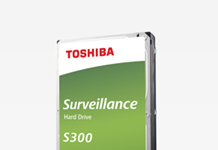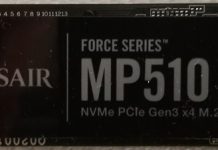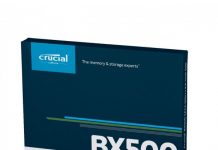|
|
Review: MPC QNAP TS-509 Reviewed by: Hi-Jack |
QNAP is one of the preferred house brands at MPC as we have several. This however does not mean we are offering a free pass and automatically conclude the products are recommended. It will have to work hard to get our recommendation just like any other device and convince us that its value and features are in balance with its cost. Do impressive hardware specifications and a tremendous list of features and options automatically mean the device is a top device? Let’s find out…
The TS-509 unit
 The unit comes packed with a power cable, manual, CD-ROM and 2 CAT 5e network cables. The body can hold up to 5 drives and for each drive, a drive cage is delivered.
The unit comes packed with a power cable, manual, CD-ROM and 2 CAT 5e network cables. The body can hold up to 5 drives and for each drive, a drive cage is delivered.
Despite the amount of drives it can hold, the unit remains reasonable in size though obviously it’s not a unit you’ll be moving around a lot. The unit measures about 26cm depth, 19cm width and 26cm height.
The 5-bays can hold SATA or SATAII hard drives and each will be hot swappable while each tray can be locked separately to prevent anyone from removing these by accident.

The unit allows up to 5TB storage capacity and could become higher as bigger hard drives become available and QNAP adds support for these.
The front of the TS-509 looks simple and incorporates a LCD display on which you can find information on the unit. From the right side, 2 buttons operate the LCD (Enter and Select). We’ll be using them to install the device completely without PC later on.

 On the left side of the front bezel is the power button followed by no less than 8 led’s, the one touch backup button and a USB 2 host socket.
On the left side of the front bezel is the power button followed by no less than 8 led’s, the one touch backup button and a USB 2 host socket.
The first in the array of led’s is the “info” led which if green means good. Anything else means you’re in trouble. The next 5 are the hard drives and activity led’s, 1 green led per drive. The orange led is for network activity and the blue one for USB.
The rear is equipped with 2 fans. A big one (12cm) for the hard drives and a small one (about 3cm) for separately cooling the PSU. How this will sound is another question we’ll answer later on.
A dual Gigabit RJ-45 is provided which can handle both “failover” and ”load balancing” operation. It is also possible to connect the TS-509 to two different networks losing the benefits of these two features: Increased stability for transfers (load balancing) and accessibility insurance (FailOver).
Advanced users will be wondering what the RS232 port (COM PORT) and VGA port are doing there. These are only for maintenance purpose.
Furthermore, 4 USB host sockets are incorporated in the rear along with a single eSATA port. The K-Lock is available and the reset button.
The 12CM fan is described as “quiet” fan. For power consumption, the unit consumes about 45 Watts in standby and 85 Watts if full operation. We expected about 90 Watts usage for the device in operational mode but the hibernation mode at 45 Watts is more than we expected.
Installation of TS-509
 What I liked instantly about the TS-509 is the way it can be installed without PC or software. All one needs is the LCD display and since the build of a RAID5 array takes quite some time, I like this option to not waste time for installation and software, not to mention the ease of installation.
What I liked instantly about the TS-509 is the way it can be installed without PC or software. All one needs is the LCD display and since the build of a RAID5 array takes quite some time, I like this option to not waste time for installation and software, not to mention the ease of installation.
Inserting the hard drives in the cage is a breeze. Once done adding the hard drives, the unit is powered on and this reveals the noise of the fans which is… quite OK really. On powerOn the fans blow quite hard but quiet down after about 30 seconds (sensors measure speed necessary).
The 4 hard drives we added to the system have a 1TB capacity and the display offers us few selections ranging from single disk install up to RAID5 and RAID6. We choose RAID5 and off it goes installing… Thirty minutes later, we have access to the administrative console while in the background the RAID SYNC continues. This process takes hours (as usual) but you can already use the device. This is where the strength of this unit processor lies… It is already very responsive while being busy working hard…
Online interface
The online interface has not changed. When connected, the main user interface offers information about the latest software releases concerning the TS-509. It feels like our own news portal for the NAS so this is well done by QNAP.

1. This is a list of services enabled on the QNAP. There are 4 default items listed here when all services are running: Web File Manager, Web Server, Download Station and Photo Station. You can choose whether these are displayed or not.

2. Second is the small news panel. This will reveal if new updates are available or packages that can be installed on your system At the moment of writing, I am updated concerning a firmware update.
Completing Installation (Setup)
Since we only configured the RAID so far, we have to complete all the other settings. Options available will be looked at now. We connect to the QNAP which is easy as the LCD shows the IP address. Entered in our browser, the QNAP interface pops up and off we go…
Quick Setup

The first item on the menu is the “Quick Configuration. This is a 6-step configuration wizard that will guide us in completing the most obvious settings on a NAS server.
- Enter the server name.
- Change the administrator password.
- Enter the date, time and time zone for this server.
- Set up the internet (WAN) TCP/IP configuration.
- Configure disk volume on this server
- Select disk configuration
First step is easy, it only asks to enter a name for the device to change the default. Given the hardware specs this baby has under the hood, we’ll go ahead and call it the MPC-Monster…

Next step is equally easy as it only wants us to change the default password (admin / admin). We go ahead and enter… right… as if I’m that stupid to tell you?

Third step in the process is all about selecting timezone and NTP settings. You can accept the default NTP server (time sync server) or enter another one.

Next step is the networking setup but limited to entering manual IP details or accepting DHCP. The more advanced configuration follows later on.

The next step is where you activate and deactivate certain services and support for protocols including CIFS, NFS, Apple, FTP, Web Server and more…
There are a total of 11 services to enable and disable and not even all possible services are installed. We’ll check our SSODS later on (Squeeze Center) and there’s the IceCAST as well.


The 5th step is actually all about creating the hard drive configuration of your choice. A warning tells us they are already configured and selecting any option other than “Do not set disk configuration” will cause data stored on these disks to be lost.

Available options are Single Disk, JBOD, RAID0, RAID1, RAID5 and RAID6. We recommend using Wikipedia for more information on these configurations if you are not familiar with them.
Notice, you can use up to 5 drives in a RAID5 / RAID6 configuration on the TS-509. For safety reasons, you can select RAID5 with 4 drives at this stage and add the 5th drive later on as “HOT SPARE”. This will cause the 5th drive to take over automatically when any of the 4 other drives fail or break down.
Now all steps have been completed that require input, the final step is all about the unit configuring itself according to the settings provided.

Wow, that was easy… and fast…
Adv. Setup: Admin Panel
Now there’s a lot more to the unit and going thru the administrative console will reveal all these. The settings so far applied are the basic ones. You can “deep tune” the TS-509 using the Admin Panel which remained the same as on the previous units.

System Settings

Since we already covered the “Quick Configuration” we move on to the second part, the “System Settings”. All items are quick links for direct jumping to the appropiate sections. Opening the “main menu” which in this case is “System Settings” will offer a left side menu with the same options.

The menu bar is filled with stylish icons which can be weird at start but one gets used to them very fast.
Server name, data and time are already set using the Quick configuration so we start with the “Filename Encoding Setting”. This setting will enable support for certain languages that require special character sets.

The SMTP configuration allows adding details for an external mail server. No separate port setting is provided but you can add the port number in the SMTP field (server:port) which is necessary to avoid the default PORT 25 being used which many ISP’s block for security.

A “test” button would help here as well to verify immediately that the SMTP settings are correct and working but there is one provided in the alert notifications we look at later on.
Last option is viewing the system settings here covering the information you have selected in this section.
Network Settings

At Network Settings you can select load balancing, failover and standalone connection for the network interface card. There are 2 gigabit connections available. When selecting either “Load Balancing” or “Failover” function, you only get to provide 1 set of IP parameters as the two interfaces will share this set. In “Standalone” mode however, you can independently provide IP paramters for each interface.


You can add the TS-509 to a workgroup as standalone server or as part of a domain.

Further services include Apple Talk Zone, NFS Service, Web File Manager, FTP Service (including passive and anonymous), Multimedia Station, iTunes, Download Stations, Web Server, DDNS Service and MySQL. It would be too much covering all but it’s all there and we are already familiar with most of them… (check any of the previous QNAP reviews for more information.)
Last are system port management where you can change the default 8080 port of the admin console and finally an overview is presented of all settings applied / changed. Although there are a lot of settings, all are easily arranged and well explained so “novice” users will know what these options apply to and what these do.

Device Configuration

No need to explain much here. Devices connected to the external ports over USB or eSATA, printers and RAID management, are being done here.
Any hard drive attached can be formatted by the QNAP in FAT, NTFS or EXT3 directly which means all three are supported for being read and attached to the QNAP as well. The options of formatting apply to both USB and eSATA attached devices.

User Management

Under user management we find a menu which allows us to select the actions we like to execute ranging from creating new users to deleting them and applying custom settings.

Quota management can be enabled globally, with a default quota value for all users. There is still a “per user” options to override the default value or disable the quote entirely. Folder quota is not supported but comes recommended.


Settings here again are very easy and straight forward. There is no administration of a Guest Account. So far we have not seen a guest account but we expect there will be one in the sections where permissions are applied to folders.
Folder Management

Well, if you speak of the devil… next is folder management where you can create the folders and set appropriate permissions, including guest level access.

Once more, everything is well arranged in a menu style and folders (as with users) are shown from a left panel. One can create new folders, remove them, set permissions and change properties on folders.
Folders can be hidden from network view (similar to PC hidden shares). Default folders created to be used with the services can be hidden as well but not renamed.

Security permissions are set by moving users and groups to the proper panels while selecting the rights to assign to these. Full Access, Read only and Deny access can be selected while for the “guest” account, a separate section is provided at the bottom.

System Tools

Alert notifications can be configured here and you can enter up to 2 mail addresses. The severity of alerts can be selected for critical issues only, all events or no events at all. You can test the mail settings as well.

Although it hasn’t been available on previous versions of QNAP firmware, they listened to the consumers by adding a flexible scheduler to arrange a scheduled downtime. The schedule provided is quite simple but can match the purpose or every custom situation. Initially you start of with a single schedule but clicking the “+” sign, adds more entries.
On the top you have direct options to reboot and shutdown and there’s a setting for Wake-On-Lan. That pretty much covers every possible thing you need and that’s just how we like it. Well done QNAP!

Hardware settings are provided where you can enable / disable the reset switch (this resets the password as well), you can set the idle time for hard drives to go in standby, add a certain amount of free space available before the QNAP warns that you are running out of disk space and enable the alarm buzzer which sounds in case anything is wrong.
An option we see for the first time is a fan setting which can be switched to “SMART” or fixed rotations speeds.

Selecting the smart option allows you to enter custom temperatures for the three different rotation speeds. This is just briliant really and definately based on user feedback…

The usual options for UPS are found further, SMART options for the hard drives (complete SMART functions) and system updates are executed from this section as well.

The USB One Touch Backup options are located here as well. Several settings are available to choose where to store the data backed up from USB drives or you can simply disable it.
Further backup options include backing up data to external devices, have remote replication and backup and restore settings applied on the TS-509.
As with the earlier models, you can still create your own logo to show on the interface.

It doesn’t stop there, as we continue with IP Filter options (allow / deny), settings for the recycle bin can be set, remote login options and last but not least, QPKG installations, and this is pure fun! We cover this after we’re done with the last item on our list concerning the admin panel.
![]()
System Logs

Last option is the system logs where several types of logs can be consulted ranging from the main system log, to connection logs, viewing online users and getting an overview of information concerning your system.

Conclusion on the setup
There is no doubt in my mind QNAP has gotten it down to offer advanced features in an easy way for these to be used by consumers, novice or advanced. Incorporating so many useful features ranging from SMART tools for HDD to formatting connected eSATA and USB drives up to allowing internal drives to be scanned internally for bad blocks and SMTP settings, scheduler and all the rest is simply put: Extremely valuable for convenience!
As far as the options are concerned and the features provided to tune these to custom situation, the QNAP has convinced me totally of it’s value, offering advanced options while staying easy to handle and configure. It is one of the best, if not the best execution implemented seen by us so far.
QPKG
QPKG is a superb solution from QNAP. Based on numerous requests to make installing add-ons easier, QNAP invented QPKG and the list of packages available is growing. These can be installed from the interface but one can also use Telnet and SSH to fiddle around on the system.

Available packages for several QNAP models thus far include SABnzbd+, Python, WordPress, Joomla, phpMyAdmin, MLDonkey, SlimServer (with SqueezeCenter 7) and “Optware IPKG” that allows installing tons of open source packages.
The way it works is simple. You download the package you want and then perform a “system upgrade” as if the file was a firmware update.
Selecting any of the packages reveals if the package is available for your model or not. The Squeeze Center at the time of writing was unavailable for the TS-509, however was added in the mean time.

The QNAP QPKG site is okept up to date although IceCast is not listed there. Notice that most of the packages that are important for media users are available at the time of closing the review for the TS-509!
We prefer QNAP to have these ready upon launch of new products and firmware although it’s just a matter of time. When these are provided within reasonable time, no one will be dissapointed. It’s waiting for the features we don’t like all that much as these are valuable reasons to choose the QNAP above other units as a media user. Packages to be provided in the near future:
- IPKG
- Sabnzbd
- MLDonkey
Performance
We ran tests using load balancing network and single network connection and the results varied accordingly. We have been most impressed with single connection performance.
Single Network Performance
Read: 41.7 MB/s average
Write: 51.2 MB.s average
Load Balancing Performance
Read: 46.5 MB/s average
Write: 45.5 MB/s average
Notice that the results heavily depend on your local network configuration. These speeds should be achieved on normal gigabit network. Load balancing does decrease the performance vs. stand alone networking.
Performance wise we were able to achieve up to 60 MB/s depending on the files and PC’s used. During copying data, a bug was found that will decrease the performance. QNAP has been alerted about this and we look forward to a fix (fixed by QNAP in the mean time). For more info, you can follow the online discussion on the TS-509!
Telnet / SSH
Although we initially missed it, some alert user informed us of the SSH/Telnet availability which is located under the System Tools / Remote Login.

Missing options
So far we are impressed but we should not loose track of the items we haven’t come across like Jumbo Frames.
We would like to have these options supported if remotely possible although jumbo frames are often overrated and only useful when needed for something else than the QNAP. These are however options that belong on any server that has the word “Pro” in its name and that includes the TS-509 pro so it should become available.
Torrent Service
The Torrent services are pretty much complete as far as options are concerned. You can set the max simultaneous downloads, port range, NAT port forwarding, and schedule the time frame in which the device is allowed to download along with up and bandwidth limits.

With the scheduling options you can set up to 2 different time frames each day for the unit to start and stop downloading.
The online client, as with the old units still has some compatibility issues with FireFox in arranging the interface but nothing severe… It is limited to not being able to rearrange the headers properly.

Adding files and consulting the properties of files is all arranged by a left hand menu. As with the other QNAP models, the interface is the same so we are already familiar with the options. If not, I refer again to one of the previous reviews of the QNAP devices where we covered the download station and other options a bit deeper.

Other features
Being a pro NAS server means incorporating all kinds of options for serving to the public. The QNAP includes several of these including MySQL, phpMyAdmin, Joomla and a list of others.
Additionally you can install several QPKG packages. The device will surely be adequate for serving small to medium web pages. To handle the “big sites” like MPC, well, a lot depends on your bandwitdh and the amount of users logged on.
















